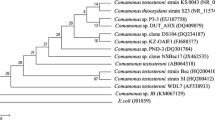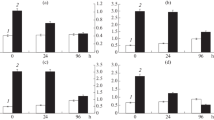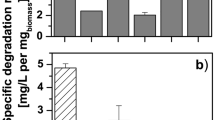Abstract
From soil samples of different origin (field, grassland and forest soils) small numbers ofNocardin andPseudomonas spec., able to utilize benzene and phenol could be isolated. Organisms which could only utilize phenol and phenolcarboxylic acids were more numerous and consisted mainly ofArthrobacter spec. It was tested to what extent these organisms could also utilize chlorinated aromatic and cyclohexane derivatives. For the degradation studies the bacteria were precultivated on benzene or p-hydroxybenzoic acid and then the compounds used were added. These compounds were labeled by14C and their degradation rates determined by measuring the14CO2 release.Pseudomonas andNocardia spec. precultivated on benzene could also degrade the chlorinated derivatives of benzene and phenol. The monochlorinated derivates were degraded more easily than the di- and trichlorinated derivates. The chlorinated benzenes, especially in higher concentrations, were less degraded than the chlorinated phenols, but with lower concentrations their degradation rates were about similar. This was due to a higher toxicity of the benzenes. The phenol utilizingArthrobacter spec. were only able to degrade phenol and the chlorinated phenols. Benzoic and m-chlorobenzoic acid were degraded to CO2 by thePseudomonas andNocardia spec. only. The benzene utilizing pseudomonads released more CO2 from γ-pentachlorocyclohexane than from γ-hexachlorocyclohexane, but none from cyclehexane. Upon precultivation of benzene utilizing pseudomonads in glucose, the aromatic compounds were also degraded, but especially the chlorinated derivatives to a lower extent.
In comparison with these soil organisms in pure culture, experiments with soil samples showed a degradation of all compounds which were used by the isolated organisms after variable induction periods. Cyclohexane was degraded slowly to CO2 by the mixed soil flora in contrast to the benzene or phenol utilizing pure cultures.
Zusammenfassung
Aus Bodenproben verschiedener Herkunft (Acker-, Rasen- und Waldböden) ließen sich Nocardien und Pseudomonaden mit der Fähigkeit zum Abbau von Benzol und Phenol in geringer Zahl isolieren und anreichern. Die nur Phenol und Phenolcarbonsäuren verwertenden Organismen waren zahlreicher und umfaßten hauptsächlichArthrobacter-Arten. Es wurde untersucht, inwieweit diese Organismen auch chlorierte Aromaten und Cyclohexane abzubauen vermögen. Für die Abbauuntersuchungen wurden die Bakterien vorher auf Benzol- bzw. aufp-Hydroxybenzoesäure kultiviert und dann die zu untersuchenden Verbindungen zugesetzt. Diese Verbindungen waren durch14C-markiert, und ihre Abbauraten wurden aufgrund der14CO2-Freisetzung gemessen.
Auf Benzol angezogene Pseudomonaden und Nocardien konnten neben Benzol und Phenol auch die einfach chlorierten Verbindungen rasch zu CO2 abbauen, die zwei- und dreifach chlorierten Verbindungen langsamer. Die chlorierten Benzole wurden besonders in höheren Konzentrationen in geringerem Maße abgebaut als die chlorierten Phenole, aber bei niedrigeren Konzentrationen stieg die Abbaurate und war etwa derjenigen der Phenole gleich. Dies ließ sich auf eine höhere Toxicität der Benzole zurückführen. Die phenolverwertendenArthrobacter-Arten konnten lediglich Phenol und die chlorierten Phenole abbauen. Benzoesäure und m-Chlorbenzoesäure wurden nur von den Pseudomonaden und Nocardien rasch zu CO2 abgebaut. Die Benzol verwertenden Pseudomonaden konnten CO2 auch aus γ-Hexachlorcyclohexan, etwas mehr aus γ-Pentachlorcyclohexen, aber nicht aus Cyclohexan freisetzen. Nach Vorkultur der Benzol verwertenden Pseudomonaden auf Glucose konnten sie die Aromaten ebenfalls abbauen, aber besonders die chlorierten Derivate im geringen Maß.
Zum Vergleich mit den Bodenorganismen wurden Versuche mit Bodenproben durchgeführt. Sie zeigten, daß alle Verbindungen, die durch die isolierten Organismen abgebaut werden konnten, nach unterschiedlichen Induktionszeiten auch im Boden abgebaut wurden. Lediglich Cyclohexan, das durch die Benzol oder Phenol verwertenden Reinkulturen nicht verwertet werden konnte, wurde durch die Mischflora des Bodens goringfügig zu CO2 abgebaut.
Similar content being viewed by others
Abbreviations
- γ-HCH:
-
γ-Hexachlorcyclohexan
- γ-PCH:
-
γ-Pentachlorcyclohexan
- PHB:
-
p-Hydroxybenzoesäure
- MHB:
-
m-Hydroxybenzoesäure
- DCB:
-
Dichlorbenzolfraktion
- TCB:
-
Trichlorbenzolfraktion
- DCB:
-
Dichlorphenolfraktion
- TCP:
-
Trichlorphenolfraktion
Literatur
Abbott, J., Gledhill, W. E.: The extracellular accumulation of metabolic products by hydrocarbon-degrading microorganisms. Advanc. appl. Microbiol.14, 249–388 (1971)
Alexander, M., Aleem, M. I. H.: Effect of chemical structure on microbial degradation of substituted benzenes. Agric. and Food Chem.9, 44–56 (1961)
Alexander, M., Lustigman, B. K.: Effect of chemical structure on microbial degradation of substituted benzenes. J. Agr. Food Chem.14, 410–413 (1966)
Audus, L. J.: Decomposition of 2,4-dichlorophenoxyacetic acid and 2-methyl-4-chlorophenoxyacetic acid in the soil. J. Sci. Food Agr.3, 268 (1952)
Audus, L. J.: Herbicide behavior in the soil. In: The physiology and biochemistry of herbicides. New York-London: Academic Press 1964
Beam, H. W., Perry, J. J.: Co-metabolism as a factor in microbial degradation of cycloparaffinic hydrocarbons. Arch. Mikrobiol.91, 87–90 (1973)
Benezet, J. H., Matsumura, F.: Isomerisation of γ-BHC to α-BHC in the environment. Nature (Lond.)243, 480–481 (1973)
Bhattacharya, P. K., Ganaphaty, K.: Microbiological transformation of terpenes. Mechanism of some fungal hydroxylation reactions with the aid of model system. Indian J. Biochem.2, 137–145 (1965)
Chadwick, R. W., Freal, J. J.: The identification of five unreported lindane metabolites recovered from rat urine. Bull. Environ. Contam. Toxicol.7, 137–146 (1972)
Dagley, S.: The microbial metabolism of phenolics. In: Soil biochemistry, A. D. McLaren and G. H. Peterson, Eds. pp, 287–314. New York: Dekker 1967
Dagley, S.: Catabolism of aromatic compounds by micro-organisms. Advanc. Microbial Physiol.6, 1–42 (1971)
Daly, J. W., Jerina, D. M., Witkop, B.: Migration of deuterium during hydroxylation of aromatic substrates by liver microsomes. Influence of ring substituents. Arch. Biochem. biophys.128, 517–527 (1968)
Dutton, P. L., Evans, W. C.: The metabolism of aromatic compounds byRhodopseudomonas palustris. A new reductive method of aromatic ring metabolism. Biochem. J.113, 525–536 (1969)
Duxbury, J. M., Thiedje, J. M., Alexander, M., Dawson, J. E.: 2,4-D metabolism: enzymatic conversion of chloromaleylacetic acid to succinic acid. J. Agr. Food Chem.18, 199–201 (1970)
Edwards, C. A.: Insecticide residues in soils. Residue Rev.13, 83–132 (1966)
Evans, W. C.: The microbiological degradation of aromatic compounds. J. Gen. Microbiol.32, 177–184 (1963)
Evans, W. C.: Microbial transformations of aromatic compounds. In: Fermentation adv., p. 649–687. D. Perlman, Ed. New York: Academic Press 1969
Freal, J. J., Chadwick, R. W.: Metabolism of hexachlorocyclohexane to chlorophenols and effect of isomer pretreatment on lindane metabolism in rat. J. Agr. Food Chem.21, 424–427 (1973)
Gibson, D. T.: Microbial degradation of aromatic compounds. Science161, 1093–1097 (1968)
Guyer, M., Hegeman, G.: Evidence for a reductive pathway for the anaerobic metabolism of benzoate. J. Bact.99, 906–907 (1969)
Haider, K.: Synthese von14C-ringmarkierten phenolischen Ligninspaltstücken und Ligninalkoholen aus Ba14CO3. J. Labelled Comp.2, 175–183 (1966)
Hemmet, R. B., Faust, S. D.: Biodegradation kinetics of 2,4 dichlorophenoxy-acetic acid by aquatic microorgamisms. Residue Rev.29, 191–207 (1969)
Hokawa, H., Schallak, A., Weissgerber, I., Klein, W., Korte, F.: Beiträge zur ökologischen Chemie. XXII: Metabolismus und Verhalten von Lindan-14C in höheren Pflanzen. Tetrahedron26, 763–768 (1970)
Horvath, R. S.: Cometabolism of the herbicide 2,3,6-trichlorobenzoate. J. Agric. Food Chem.19, 291–293 (1971)
Horvath, R.: Microbial co-metabolism and the degradation of organic compounds in nature. Bact. Rev.36, 146–155 (1972)
Imelik, B.: Oxydation de cyclohexane parPseudomonas aeruginosa. C. R. Soc. Biol. (Paris)226, 2082–2083 (1948)
Jagnow, G.: Eine Methode zur spezifischen Anreicherung, Isolierung und Anzucht von Benzol abbanenden Nocardien und Pseudomonaden aus Boden. Soil Biol. Internat. News. Bull., New Ser.16, 4–5 (1972)
Lichtenstein, E. P., Schulz, K. R.: Breakdown of lindane and aldrin in soils. J. Econ. Entom.52, 118–124 (1959)
Loos, M. A., Roberts, R. N., Alexander, M.: Phenols as intermediates in the decomposition of phenoxyacetates by anArthrobacter species. Canad. J. Microbiol.13, 679–690 (1967)
Loos, M. A.: Phenoxyaleanoic acids. In: Degradation of herbicides, C. Kearney and D. D. Kaufman, Eds., pp. 1–49. New York: Dekker 1969
MacRae, I. C., Alexander, M., Rovira, A. D.: The decomposition of 4-(2,4-Dichlorophenoxy) butyric acid byFlavobacterium sp. J. gen. Microbiol.32, 69–76 (1963)
MacRae, I. C., Raghu, K., Bautista, E. M.: Anaerobic degradation of the insecticide lindane byClostridium spec. Nature (Lond.)221, 859–860 (1969)
MacRae, I. C., Raghu, K., Castro, T. F.: Persistence and biodegradation of four common isomers of benzene hexachloride in submerged soils. J. Agr. Food Chem.15, 911–914 (1967)
Matsumura, F., Boush, G. M.: Metabolism of insecticides by microorganisms. In: Spil biochemistry, Vol. 2, A. D. McLaren and J. Skujins, Eds., pp. 320–336. New York: Dekker 1971
Murray, A., Williams, D. L.: Organic synthesis with isotopes, 1094 pp. New York: Interscience 1958
Ooyama, J., Foster, J. W.: Bacterial oxidation of cycloparaffinic hydrocarbons. Antonie v. Leeuwenhoek31, 45–65 (1965)
Raghu, K., Mac Rae, J. C.: Biodegradation of the γ-isomer of benzene hexachloride in submerged soils. Science154, 263–265 (1966)
Reber, H.: Comparative studies with two Pseudomonads on the sequential degradation of aromatic substances metabolized via different pathways. Arch. Mikrobiol.89, 305–315 (1973)
Reed, W. T.: Metabolism of lindane to tetrachlorobenzene. J. Agr. Food Chem.17, 896–897 (1969)
Reed, W. T.: Metabolism of lindane to organic soluble products by houseflies. J. Agr. Food Chem.18, 475–480 (1970)
Reed, W. T., Forgash, A. J.: Lindane metabolism to a new isomer of pentachlorocyclohexene. Science160, 1232–1234 (1968)
Skita, A., Meyer, W. A.: Über die Hydrierung von Aldehyden und Ketonen sowie von aromatischen und heterocyclischen Stoffen in kolloiden Lösungen. Katalytische Hydrierungen VIII. Ber. dtsch. chem. Ges.45, 3589–3595 (1912)
Stanier, R. Y., Palleroni, N. J., Doudoroff, M.: The aerobic pseudomonads: A taxonomic study. J. gen. Microbiol.13, 159–271 (1966)
Stewart, D. J.: A composite arginine glucose medium for the characterization ofPseudomonas aeruginosa and other gram-negative bacilli. J. appl. Bact.34, 779–786 (1971)
Stroh, R.: Herstellung von Chlorverbindungen. In: Houben-Weyl, Methoden der organischen Chemie, Bd. V/3, S. 503–1017. Stuttgart: Thieme 1962
Tabak, H. H., Chambers, C. W., Kabler, P. W.: Microbial metabolism of phenolic compounds and aromatic hydrocarbons by phenoladapted bacteria. J. Bact.87, 910–919 (1964)
Thiedje, J. M., Duxbury, J. M., Alexander, M., Dawson, J. E.: 2,4-D metabolism: Pathway of degradation of chlorocatechols byArthrobacter sp. J. Agr. Food Chem.17, 1021–1026 (1969)
Thiegs, B. J.: Microbial decomposition of herbicides. Down to Earth18, 7–10 (1962)
Tranter, E. K., Cain, R. B.: Degradation of fluoro aromatic compounds to fluoro citrate and fluoro acetate by bacteria. Biochem. J.103, 22P-23P (1967)
Wieland, I., Griss, G., Haccius, B.: Untersuchungen zur mikrobiellen Benzoloxydation. Arch. Mikrobiol.28, 383–393 (1958)
Yule, W., Chiba, M., Morley, H. V.: Fate of insecticide residues: Decomposition of lindane in soil. J. Agr. Food Chem.15, 1000–1004 (1967)
Author information
Authors and Affiliations
Additional information
Heimatanschrift: Secul National University, Suwon, Korea.
Rights and permissions
About this article
Cite this article
Haider, K., Jagnow, G., Kohnen, R. et al. Abbau chlorierter Benzole, Phenole und Cyclohexan-Derivate durch Benzol und Phenol verwertende Bodenbakterien unter aeroben Bedingungen. Arch. Microbiol. 96, 183–200 (1974). https://doi.org/10.1007/BF00590175
Received:
Issue Date:
DOI: https://doi.org/10.1007/BF00590175




